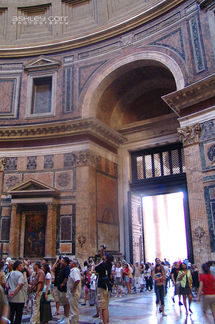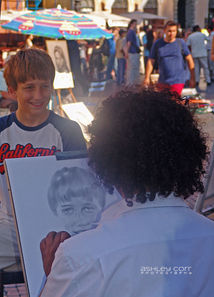

Portfolio > On Location (Overseas) > Rome, Italy Click on an image below to reveal enlarged version

Rome
Rome is the capital city of Italy. It is also the capital of the Lazio region, the centre of the Metropolitan City of Rome, and a special comune named Comune di Roma Capitale. With 2,860,009 residents in 1,285 km2 (496.1 sq mi), Rome is the country's most populated comune and the third most populous city in the European Union by population within city limits. The Metropolitan City of Rome, with a population of 4,355,725 residents, is the most populous metropolitan city in Italy. Its metropolitan area is the third-most populous within Italy. Rome is located in the central-western portion of the Italian Peninsula, within Lazio (Latium), along the shores of the Tiber. Vatican City (the smallest country in the world) is an independent country inside the city boundaries of Rome, the only existing example of a country within a city; for this reason, Rome has sometimes been described as the capital of two states. Rome is often referred to as the City of Seven Hills due to its geographic location, and also as the "Eternal City". Rome is generally considered to be the "cradle of Western christian culture and civilization", and the center of the Catholic Church. Rome's history spans 28 centuries. While Roman mythology dates the founding of Rome at around 753 BC, the site has been inhabited for much longer, making it a major human settlement for almost three millennia and one of the oldest continuously occupied cities in Europe. The city's early population originated from a mix of Latins, Etruscans, and Sabines. Eventually, the city successively became the capital of the Roman Kingdom, the Roman Republic and the Roman Empire, and is regarded by many as the first-ever Imperial city and metropolis. It was first called The Eternal City by the Roman poet Tibullus in the 1st century BC, and the expression was also taken up by Ovid, Virgil, and Livy.
Rome is also called "Caput Mundi" (Capital of the World). After the fall of the Empire in the west, which marked the beginning of the Middle Ages, Rome slowly fell under the political control of the Papacy, and in the 8th century, it became the capital of the Papal States, which lasted until 1870. Beginning with the Renaissance, almost all popes since Nicholas V (1447–1455) pursued a coherent architectural and urban programme over four hundred years, aimed at making the city the artistic and cultural centre of the world. In this way, Rome became first one of the major centres of the Renaissance, and then the birthplace of both the Baroque style and Neoclassicism. Famous artists, painters, sculptors, and architects made Rome the centre of their activity, creating masterpieces throughout the city. In 1871, Rome became the capital of the Kingdom of Italy, which, in 1946, became the Italian Republic.
In 2019, Rome was the 11th most visited city in the world, with 10.1 million tourists, the third most visited in the European Union, and the most popular tourist destination in Italy. Its historic centre is listed by UNESCO as a World Heritage Site. The host city for the 1960 Summer Olympics, Rome is also the seat of several specialised agencies of the United Nations, such as the Food and Agriculture Organization (FAO), the World Food Programme (WFP) and the International Fund for Agricultural Development (IFAD). The city also hosts the Secretariat of the Parliamentary Assembly of the Union for the Mediterranean (UfM) as well as the headquarters of many international businesses, such as Eni, Enel, TIM, Leonardo S.p.A., and national and international banks such as Unicredit and BNL. Rome's EUR business district is the home of many oil industry, the pharmaceutical industry, and financial services companies. The presence of renowned international brands in the city has made Rome an important centre of fashion and design, and the Cinecittà Studios have been the set of many Academy Award–winning movies.
History
While there have been discoveries of archaeological evidence of human occupation of the Rome area from approximately 14,000 years ago, the dense layer of much younger debris obscures Palaeolithic and Neolithic sites. Evidence of stone tools, pottery, and stone weapons attest to about 10,000 years of human presence. Several excavations support the view that Rome grew from pastoral settlements on the Palatine Hill built above the area of the future Roman Forum. Between the end of the Bronze Age and the beginning of the Iron Age, each hill between the sea and the Capitol was topped by a village (on the Capitol Hill, a village is attested since the end of the 14th century BC). However, none of them yet had an urban quality. Nowadays, there is a wide consensus that the city developed gradually through the aggregation ("synoecism") of several villages around the largest one, placed above the Palatine. This aggregation was facilitated by the increase of agricultural productivity above the subsistence level, which also allowed the establishment of secondary and tertiary activities. These, in turn, boosted the development of trade with the Greek colonies of southern Italy (mainly Ischia and Cumae). These developments, which according to archaeological evidence took place during the mid-eighth century BC, can be considered as the "birth" of the city. Despite recent excavations at the Palatine hill, the view that Rome was founded deliberately in the middle of the eighth century BC, as the legend of Romulus suggests, remains a fringe hypothesis.
Late Modern And Contemporary
The rule of the Popes was interrupted by the short-lived Roman Republic (1798–1800), which was established under the influence of the French Revolution. The Papal States were restored in June 1800, but during Napoleon's reign Rome was annexed as a Département of the French Empire: first as Département du Tibre (1808–1810) and then as Département Rome (1810–1814). After the fall of Napoleon, the Papal States were reconstituted by a decision of the Congress of Vienna of 1814. In 1849, a second Roman Republic was proclaimed during a year of revolutions in 1848. Two of the most influential figures of the Italian unification, Giuseppe Mazzini and Giuseppe Garibaldi, fought for the short-lived republic. Rome then became the focus of hopes of Italian reunification after the rest of Italy was united as the Kingdom of Italy in 1861 with the temporary capital in Florence. That year Rome was declared the capital of Italy even though it was still under the Pope's control. During the 1860s, the last vestiges of the Papal States were under French protection thanks to the foreign policy of Napoleon III. French troops were stationed in the region under Papal control. In 1870 the French troops were withdrawn due to the outbreak of the Franco-Prussian War. Italian troops were able to capture Rome entering the city through a breach near Porta Pia. Pope Pius IX declared himself a prisoner in the Vatican. In 1871 the capital of Italy was moved from Florence to Rome. In 1870 the population of the city was 212,000, all of whom lived with the area circumscribed by the ancient city, and in 1920, the population was 660,000. A significant portion lived outside the walls in the north and across the Tiber in the Vatican area.
Bombardment Of Rome By Allied Planes, 1943
Soon after World War I in late 1922 Rome witnessed the rise of Italian Fascism led by Benito Mussolini, who led a march on the city. He did away with democracy by 1926, eventually declaring a new Italian Empire and allying Italy with Nazi Germany in 1938. Mussolini demolished fairly large parts of the city centre in order to build wide avenues and squares which were supposed to celebrate the fascist regime and the resurgence and glorification of classical Rome. The interwar period saw a rapid growth in the city's population which surpassed one million inhabitants soon after 1930. During World War II, due to the art treasuries and the presence of the Vatican, Rome largely escaped the tragic destiny of other European cities. However, on 19 July 1943, the San Lorenzo district was subject to Allied bombing raids, resulting in about 3,000 fatalities and 11,000 injuries, of whom another 1,500 died. Mussolini was arrested on 25 July 1943. On the date of the Italian Armistice 8 September 1943 the city was occupied by the Germans. The Pope declared Rome an open city. It was liberated on 4 June 1944. Rome developed greatly after the war as part of the "Italian economic miracle" of post-war reconstruction and modernisation in the 1950s and early 1960s. During this period, the years of la dolce vita ("the sweet life"), Rome became a fashionable city, with popular classic films such as Ben Hur, Quo Vadis, Roman Holiday and La Dolce Vita filmed in the city's iconic Cinecittà Studios. The rising trend in population growth continued until the mid-1980s when the comune had more than 2.8 million residents. After this, the population declined slowly as people began to move to nearby suburbs.























